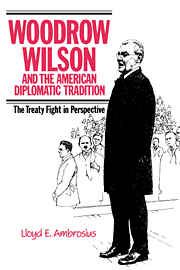Book contents
- Frontmatter
- Contents
- Preface
- Acknowledgments
- List of abbreviations
- 1 Introduction: Wilson's new world
- 2 Origins of Wilson's league of nations idea
- 3 Drafting of the League of Nations Covenant
- 4 American criticism of Wilson's peacemaking
- 5 Revision of the League of Nations Covenant
- 6 The question of control at home and abroad
- 7 The Versailles Treaty in the Senate
- 8 American rejection of the Versailles peace
- 9 The aftermath of Wilson's peacemaking
- 10 Epilogue: Wilson's legacy
- Bibliography
- Index
3 - Drafting of the League of Nations Covenant
Published online by Cambridge University Press: 18 September 2009
- Frontmatter
- Contents
- Preface
- Acknowledgments
- List of abbreviations
- 1 Introduction: Wilson's new world
- 2 Origins of Wilson's league of nations idea
- 3 Drafting of the League of Nations Covenant
- 4 American criticism of Wilson's peacemaking
- 5 Revision of the League of Nations Covenant
- 6 The question of control at home and abroad
- 7 The Versailles Treaty in the Senate
- 8 American rejection of the Versailles peace
- 9 The aftermath of Wilson's peacemaking
- 10 Epilogue: Wilson's legacy
- Bibliography
- Index
Summary
At the Paris Peace Conference of 1919, Wilson sought to transform his vision of postwar collective security into an international organization. This process revealed both the idealistic and practical aspects of his character. To achieve his goal, which others regarded as a vague ideal, he engaged in a very practical form of diplomacy. He made concessions, especially to the British, to win their cooperation in drafting the Covenant. During these negotiations and in his conception of the League itself, Wilson expected the United States to play a predominant role. His vision of a new world order, although articulated in universal terms, would allow the United States to continue its unilateral approach in foreign relations. He thought American control over international affairs would benefit other nations as well as his own. From this perspective, he easily reconciled his understanding of American nationalism and his brand of internationalism. Identifying his own country's interests with the world's, the president combined isolationist and internationalist elements in his foreign policy.
Wilson emphasized the future League's redeeming mission in world affairs. In Paris, while awaiting the opening of the peace conference, he outlined his idea of the League as an instrument to prevent absolutism and militarism from again threatening human liberty. He emphasized the function of public opinion in maintaining peace.
- Type
- Chapter
- Information
- Woodrow Wilson and the American Diplomatic TraditionThe Treaty Fight in Perspective, pp. 51 - 79Publisher: Cambridge University PressPrint publication year: 1987
- 1
- Cited by



